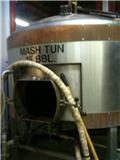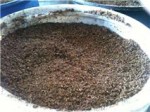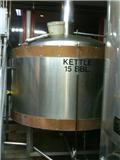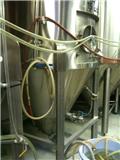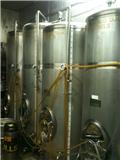 I was looking through a catalog the other day to find a vine suitable for the obelisk in the formal garden and came upon hops. Two kinds were listed, one a “high alpha-acid (bittering) type” and the other an “aroma-type”. I knew that hops were used in beer making but had no clue as to how they were used. I was drawn to the plant because I love green odd looking flowers and remember how lovely the vines looked in an English garden I visited years ago. When a friend called last week and suggested a visit to beer school at a local brewery I knew that I was destined to have a future with hops.
I was looking through a catalog the other day to find a vine suitable for the obelisk in the formal garden and came upon hops. Two kinds were listed, one a “high alpha-acid (bittering) type” and the other an “aroma-type”. I knew that hops were used in beer making but had no clue as to how they were used. I was drawn to the plant because I love green odd looking flowers and remember how lovely the vines looked in an English garden I visited years ago. When a friend called last week and suggested a visit to beer school at a local brewery I knew that I was destined to have a future with hops.
My expectations were exceeded and I recommend beer school for anyone with the slightest interest in beer or hops. We came away with a wealth of interesting facts about beer, how it is produced, and the role of hops. The catalog phrases used to describe the two kinds of hops now make sense but I also learned that hops grows best in the Pacific Northwest where the limey soil is to their liking. Well, darn!
Hops is used in the brewing process for many reasons. It provides bitterness to balance the sweetness of the malt, adds other flavors and aroma, and stabilizes the brew by inhibiting the activity of organisms that may contaminate it. The degree of bitterness is 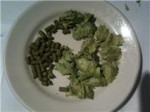 indicated by the IBU (International Bitterness Unit). The scale goes from 0 to 120 with light American lagers around 10, American pale ales in the 30s, American IPA (India Pale Ale) between 40 and 70, and American barleywine at 120. The female flowers of the hops vine are used in the brewing either dried or made into pellets (see picture at right). There are many different varieties of hops each with its own degree of bitterness, and more or less other flavors including. Flavors and aromas include grassy, earthy, citrus, and floral. Hops are generally put into one of two groups on the basis of relative amounts of aroma and bitterness: noble hops are those that are high in aroma and low in bitterness while high alpha hops provide more bitterness. Some hops are in a third group that provide both aroma and bitterness.
indicated by the IBU (International Bitterness Unit). The scale goes from 0 to 120 with light American lagers around 10, American pale ales in the 30s, American IPA (India Pale Ale) between 40 and 70, and American barleywine at 120. The female flowers of the hops vine are used in the brewing either dried or made into pellets (see picture at right). There are many different varieties of hops each with its own degree of bitterness, and more or less other flavors including. Flavors and aromas include grassy, earthy, citrus, and floral. Hops are generally put into one of two groups on the basis of relative amounts of aroma and bitterness: noble hops are those that are high in aroma and low in bitterness while high alpha hops provide more bitterness. Some hops are in a third group that provide both aroma and bitterness.
Of course, hops is not the only important ingredient in beer. Beer is 90% water and the flavor and softness of the water can affect the finished product. More important is the grain which provides the food on which the yeast feed to produce ethanol (alcohol) and 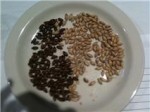 carbon dioxide. The most common grains used are malted barley, wheat, rice, corn, or millet. In the malting process, the grain is put into a wet, moist environment until it plumps up and almost germinates, and then is kilm roasted, a short time for light colored beers, a longer time for dark beers (see picture of light and dark roasted barley are on the left.) The roasting influences the flavor of the beer but is not related to the alcohol content so that there are dark and light beers with both high and low alcohol content. The color is measured by a scale known as the SRM (Standard Reference Method) . A typical American pale ale has a rating of 2 (light golden yellow), a dark lager 17 (medium red brown), stout 35 (very dark brown), and imperial stout 70 (black-looking).
carbon dioxide. The most common grains used are malted barley, wheat, rice, corn, or millet. In the malting process, the grain is put into a wet, moist environment until it plumps up and almost germinates, and then is kilm roasted, a short time for light colored beers, a longer time for dark beers (see picture of light and dark roasted barley are on the left.) The roasting influences the flavor of the beer but is not related to the alcohol content so that there are dark and light beers with both high and low alcohol content. The color is measured by a scale known as the SRM (Standard Reference Method) . A typical American pale ale has a rating of 2 (light golden yellow), a dark lager 17 (medium red brown), stout 35 (very dark brown), and imperial stout 70 (black-looking).
Alcohol content is expressed as ABU, alcohol by volume. It varies from about 1% to 20% but most beers are in the 4-6% range. The alcohol content is dependent upon the quantity of sugars supplied by the grain and the variety of yeast used. The addition of fermentable sugars and the use of champagne yeast have allowed the production of beers/ales with an ABU over 20%.
The brewing process begins with milling the grain, that is, cracking the grain so that the starch is exposed. In this condition the grain is called grist. Next the starch in the grain is extracted and converted into maltose (a sugar) with heated water in the mash tub.
The sugar-water mixture is called wort and the residue from the grain, “spent grain”, is called the mash. In a process called lautering the wort is drawn off and rinsed (sparging) to make beer and the mash sold or given to local farmers for livestock feed.
Boiling the wort homogenizes and sterilizes it; in addition some carmelization may occur that will effect color and flavor. While the wort is boiling, hops are added for bitterness, flavor, and aroma.
After boiling the wort is cooled by moving it through a heat exchanger and then into a fermentation tank where yeast is added. If ale is wanted, top fermenting yeast are added and the brew is kept at 60o – 70o F. for 4-10 days. If lager is wanted, bottom fermenting yeast are added and the brew is kept at 52o F. for the 7-14 days. The brew may be carbonated at the end of fermentation.
Sometimes things get pretty active.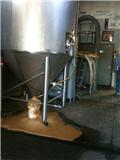
After fermentation the brew is conditioned in various ways depending on the desired outcome. The conditioning allows the beer to age and the flavors to fuse. Lager beers are conditioned at temperatures just above freezing for 1-6 months in order to reduce the sulfur compounds produced by the yeast. Beers are usually conditioned in special tanks, casks, or barrels. One of the tastiest beers we had was conditioned in a bourbon barrel. Yummm… After conditioning, most beers are filtered to remove particulate matter and improve clarity. Then the beer may be bottled, kegged, or put in serving tanks for use on site.
Thanks go to Foothill Brewing in Winston-Salem, North Carolina, for an interesting and enjoyable beer school experience.
